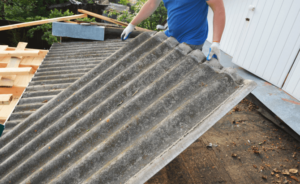What Is Occupational Asbestos Exposure?
Occupational asbestos exposure occurs when a worker is exposed to asbestos, a known carcinogen, while they are performing their job duties. Asbestos could be found on almost every worksite up until the mid-1980s.

Most jobs that put workers at risk of asbestos exposure — and asbestos-related diseases such as mesothelioma, lung cancer, and asbestosis — were performed by hard-working blue-collar employees like construction workers and mechanics. These workers used their hands to make an honest living and provide for their families.
Even a brief exposure to asbestos fibers can be harmful.
“There is no ‘safe’ level of asbestos exposure for any type of asbestos fiber.”
– Occupational Safety and Health Administration (OSHA)
Workers often inhaled or swallowed microscopic asbestos fibers when they handled or repaired asbestos-containing products. Insulation, gaskets, brakes, and pumps are just a few examples of products that routinely contained asbestos.
Sadly, workers had no idea that they were being put in harm’s way. Asbestos-related diseases have a long latency period. As a result, it can take 20-50 years for a person to experience symptoms after their initial exposure to asbestos.
Additionally, many companies that manufactured these products knew they were dangerous and could cause cancer, but they hid the truth from the public to keep making money.
Quick Facts About Occupational Asbestos Exposure
- About 27 million workers in the U.S. were exposed to asbestos fibers in the air from 1940 to 1979, according to the Agency for Toxic Substances and Disease Registry (ATSDR).
- Today, the workers most likely to be exposed to asbestos are those who work in the construction industry, ATSDR reports. Many older buildings still contain asbestos-containing construction materials.
- Family members can be exposed to asbestos that workers carry home on their clothes or body.
- Workers who did not directly handle asbestos products but shared a workspace with others who did are also at risk of developing asbestos-related diseases.
Need help with an occupational asbestos exposure claim? Contact our team today at (888) 726-9160 for a free case review.
Top Asbestos At-Risk Occupations
As OSHA has stated, “there is no ‘safe’ level of asbestos exposure.” However, some jobs presented workers with an increased asbestos exposure risk.
Workers in these occupations typically faced a higher risk of asbestos exposure:

Auto mechanics: Auto mechanics handled asbestos-laden car parts such as clutches, brake pads, brake linings, and gaskets. Even today, some brakes and clutches still contain asbestos. It is impossible to tell whether brake or clutch parts contain asbestos merely by looking at them, according to the U.S. Environmental Protection Agency (EPA).
Construction workers: Construction workers not only handled many different types of asbestos products, but they also cut, drilled, and sanded some of these dangerous products. This work could cause asbestos dust to be released into the air and endanger anyone on the job site. Asbestos-containing building materials include caulk, cement, drywall, floor tiles, and paint.
Firefighters: Structures that contain asbestos can release asbestos fibers when they catch fire. Even asbestos fireproofing materials meant to keep people safe can release asbestos during a blaze. First responders who rushed into buildings to extinguish flames or save people trapped inside were at risk of breathing in asbestos.
A study by the National Institute for Occupational Safety and Health (NIOSH) found that U.S. firefighters were more than twice as likely to develop mesothelioma than the general population.
Factory workers: It was not unusual for factory workers to work with or around asbestos. A talc supplier recently agreed to pay $72.5 million to settle claims alleging that its talc was contaminated with asbestos and caused hundreds of rubber plant workers to develop asbestos-related diseases. The workers used talc to dust the rubber and prevent it from sticking.
Insulators: Different types of asbestos insulation were commonly used in the construction of homes, schools, factories, and other structures. Workers who cut, sprayed, and installed asbestos insulation were at risk of inhaling asbestos fibers and developing malignant mesothelioma and other asbestos-related diseases.
At one time, some spray-on insulation consisted of as much as 85% asbestos.
Plumbers and pipefitters: Plumbers and pipefitters may have been exposed to asbestos when they cut, repaired, or installed pipe. Piping often contained asbestos, as did pipe insulation, joint compounds, and pumps.
Roofers: Not only did some roofing shingles contain asbestos, but so did roofing asphalt, felt, and coatings. As a result, roofers have historically had an elevated risk of asbestos exposure.
Shipyard workers: Shipyards were one of the most dangerous job sites for asbestos exposure. Asbestos was used to build ships because it was strong and water- and heat-resistant. Workers used asbestos materials when they built the body of vessels.
They may have also come in contact with asbestos fibers when they worked with or around asbestos-laden pumps, boilers, valves, and gaskets. Unfortunately, many U.S. Navy veterans who worked building or maintaining ships or served on them were exposed to asbestos and developed mesothelioma.
If you or a loved one worked in one of these or other asbestos at-risk occupations and later developed an asbestos-related disease, you may be eligible for financial compensation.
Other Asbestos At-Risk Occupations
Certainly, the jobs listed above are not the only ones that placed workers in peril. Anyone who worked with or around asbestos was at risk of occupational asbestos exposure.
Asbestos at-risk jobs also include:
- Boilermakers
- Bricklayers
- Building inspectors
- Carpenters
- Drywallers
- Electricians
- Heavy equipment operators
- HVAC technicians
- Ironworkers
- Laborers
- Maintenance workers
- Metal workers
- Miners
- Oil refinery workers
- Painters
- Power plant workers
- Railroad workers
- Steamfitters
- Steelworkers
- Tile installers
- Welders
Veterans and Occupational Asbestos Exposure
Americans who served in all branches of the military were in danger of occupational asbestos exposure, both at home and abroad. Asbestos could be found throughout military bases, including in housing, vehicles, and equipment.
Approximately 1 in 3 people diagnosed with mesothelioma are U.S. military veterans.
Many military members served in asbestos at-risk occupations and handled dangerous asbestos products or worked around others who did.
For example, some military personnel worked as:
- Aircraft and auto mechanics
- Carpenters
- Electricians
- Pipefitters
- Ship builders
- Welders
The U.S. Department of Veterans Affairs suggests that veterans get tested for illnesses that affect their lungs if they worked in one of these industries:
- Carpentry
- Construction
- Demolition
- Milling
- Mining
- Shipyards
Veterans with mesothelioma or other asbestos-related diseases may be entitled to VA benefits and may also be able to pursue legal compensation against manufacturers of asbestos-containing materials.
A LawFirm.com team member can help you access VA benefits. Contact us right now to get started.
Women and Occupational Asbestos Exposure
While occupational asbestos exposure is mostly reported in men, women are also at risk.
In May 2022, the Centers for Disease Control and Prevention (CDC) analyzed the deaths of women with mesothelioma from 1999-2020.
The CDC attributed 23% of those deaths to work-related asbestos exposure. In comparison, the agency said approximately 85% of mesotheliomas among men were attributable to occupational asbestos exposure.
According to the report, women who worked in these industries were most at risk:
- Education
- Health care and social services
- Manufacturing
The occupations with the most mesothelioma deaths were:
- Homemakers
- Elementary and middle school teachers
- Registered nurses
Family Members of Workers in Asbestos At-Risk Occupations
Not only were millions of American workers in jeopardy of asbestos exposure and related health risks but so were their families.
Workers often carried asbestos dust home on their clothes, skin, and hair. As a result, family members ran the risk of inhaling these microscopic fibers and suffering adverse health effects. This type of asbestos exposure is called secondary or take-home exposure.
Additionally, it was not unusual for workers to toss their asbestos-contaminated work clothes into the family laundry bin at the end of the workday. It was possible for the dirty work clothes to contaminate other clothing inside the bin or inside the washing machine.
Anyone who laundered the worker’s work clothes — usually the worker’s wife — was especially at risk.
One study found that household exposure led to an increased risk of pleural mesothelioma among women who had no occupational asbestos exposure. Another study estimated that take-home asbestos resulted in 20% of mesothelioma cancers diagnosed in Canadian females in a one-year period.
Lastly, people who lived near asbestos-contaminated factories or mines were in danger of getting sick from breathing in asbestos dust in the air.
If you or a loved one were diagnosed with an asbestos-related disease and lived with someone who worked around asbestos, you may be able to pursue compensation.
Contact one of our team members today to learn more about how secondary asbestos exposure may have affected you and your family. You may have legal options available to you.
Compensation for Occupational Asbestos Exposure

Mesothelioma patients and other patients who have been diagnosed with asbestos-related diseases after working in asbestos-at-risk occupations may be able to pursue financial compensation.
Occupational asbestos victims may be entitled to compensation from one or more of these sources:
- Asbestos lawsuits: An asbestos lawsuit is one way that asbestos victims can seek compensation to help pay for medical treatments, lost wages, and more. If successful, an asbestos lawsuit — through a settlement or verdict — often provides families with financial security and peace of mind.
- Asbestos trust funds: Companies that produced asbestos-containing goods were court-ordered to set aside money in asbestos trust funds to compensate current and future asbestos victims. Currently, there is about $30 billion available in trust fund money.
- VA benefits: The VA offers benefits to veterans who developed mesothelioma, asbestosis, and other asbestos-related diseases after being exposed to asbestos while they served.
Proving Occupational Asbestos Exposure
People diagnosed with mesothelioma and other asbestos-related diseases may not know how they were exposed to asbestos or who is responsible for making them sick.
The good news is that an experienced asbestos lawyer may be able to determine when, where, and how an asbestos victim’s exposure occurred. These attorneys have resources that help connect a client’s disease to the manufacturers who are to blame.
In most cases, multiple manufacturers are responsible for causing a worker’s occupational asbestos exposure. For example, a mechanic could have been exposed to asbestos-laden brakes, clutches, and gaskets manufactured by different auto parts companies.
Generally speaking, the more asbestos manufacturers named in a lawsuit, the more compensation an asbestos victim is likely to win.
Get Help With an Occupational Asbestos Exposure Claim
Many companies that manufactured asbestos-containing products knew for decades that their products were dangerous and had the potential to cause cancer. However, they decided to cover up the truth, so they could continue to make money.
This blatant disregard for the health and safety of American workers is simply unacceptable. Manufacturers that hid the truth about the cancer risk connected to their products should be held accountable.
These companies should be the ones paying for your medical expenses, lost income, and more.
The asbestos law firms we partner with will vigorously fight for maximum compensation for you and your family. These law firms have decades of experience handling asbestos claims across the country, and they don’t charge any fees until they recover compensation for you.
To get started with a free case review, contact our team today at (888) 726-9160.
FAQs About Occupational Asbestos Exposure
What industries use asbestos?
Nearly every industry used asbestos in some capacity prior to the mid-1980s.
These industries, for example, relied heavily on asbestos-laden products:
- Automotive
- Construction
- Manufacturing
- Mining
- Shipbuilding
- Steel
Who is exposed to asbestos?
Anyone can be exposed to asbestos. People who find themselves near a source of asbestos that has been disturbed run the risk of inhaling or swallowing microscopic asbestos fibers that have become airborne.
Individuals have been exposed to asbestos in a variety of settings — at school, work, and even at home.
Who is most at risk for asbestos exposure?
Generally speaking, U.S. military veterans and blue-collar workers are most at risk for asbestos exposure.
Use of asbestos was widespread across every branch of the military. For example, asbestos could be found in military housing and vehicles, and service members often handled asbestos-laden products like piping, pumps, and gaskets when they performed their jobs.
Outside of the military, some asbestos high-risk occupations include:
- Auto mechanics
- Construction workers
- Firefighters
- Shipyard workers
Can you sue for working around asbestos?
Yes, you may be able to sue the manufacturer of an asbestos-containing product if you or a loved one developed mesothelioma or another asbestos-related disease after working with the product.

 Get Legal Help Now
Get Legal Help Now

